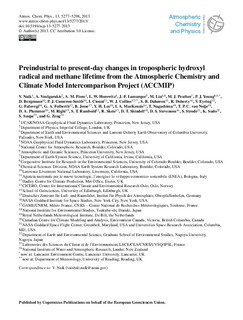| dc.description.abstract | We have analysed time-slice simulations from 17 global models, participating in the Atmospheric Chemistry and Climate Model Intercomparison Project (ACCMIP), to explore changes in present-day (2000) hydroxyl radical (OH) concentration and methane (CH4) lifetime relative to preindustrial times (1850) and to 1980. A comparison of modeled and observation-derived methane and methyl chloroform lifetimes suggests that the present-day global multimodel mean OH concentration is overestimated by 5 to 10% but is within the range of uncertainties. The models consistently simulate higher OH concentrations in the Northern Hemisphere (NH) compared with the Southern Hemisphere (SH) for the present-day (2000; inter-hemispheric ratios of 1.13 to 1.42), in contrast to observation-based approaches which generally indicate higher OH in the SH although uncertainties are large. Evaluation of simulated carbon monoxide (CO) concentrations, the primary sink for OH, against ground-based and satellite observations suggests low biases in the NH that may contribute to the high north–south OH asymmetry in the models. The models vary widely in their regional distribution of present-day OH concentrations (up to 34 %). Despite large regional changes, the multi-model global mean (mass-weighted) OH concentration changes little over the past 150 yr, due to concurrent increases in factors that enhance OH (humidity, tropospheric ozone, nitrogen oxide (NOx) emissions, and UV radiation due to decreases in stratospheric ozone), compensated by increases in OH sinks (methane abundance, carbon monoxide and non-methane volatile organic carbon (NMVOC) emissions). The large inter-model diversity in the sign and magnitude of preindustrial to present-day OH changes (ranging from a decrease of 12.7% to an increase of 14.6 %) indicate that uncertainty remains in our understanding of the long-term trends in OH and methane lifetime. We show that this diversity is largely explained by the different ratio of the change in global mean tropospheric CO and NOx burdens (1CO/1NOx, approximately represents changes in OH sinks versus changes in OH sources) in the models, pointing to a need for better constraints on natural precursor emissions and on the chemical mechanisms in the current generation of chemistry-climate models. For the 1980 to 2000 period, we find that climate warming and a slight increase in mean OH (3.5±2.2 %) leads to a 4.3±1.9% decrease in the methane lifetime. Analysing sensitivity simulations performed by 10 models, we find that preindustrial to presentday climate change decreased the methane lifetime by about four months, representing a negative feedback on the climate system. Further, we analysed attribution experiments performed by a subset of models relative to 2000 conditions with only one precursor at a time set to 1860 levels. We find that global mean OH increased by 46.4±12.2% in response to preindustrial to present-day anthropogenic NOx emission increases, and decreased by 17.3±2.3 %, 7.6±1.5 %, and 3.1±3.0% due to methane burden, and anthropogenic CO, and NMVOC emissions increases, respectively. | |
